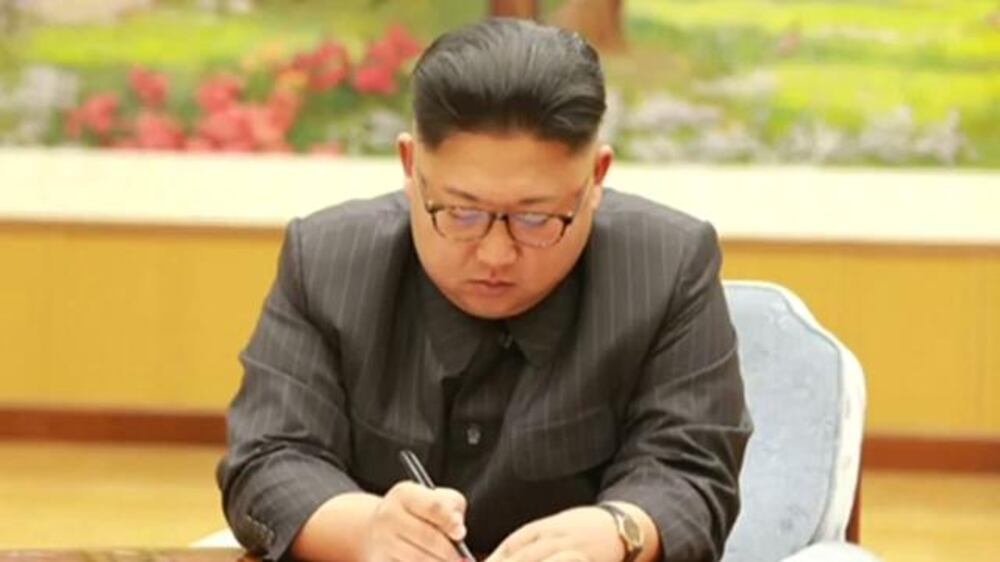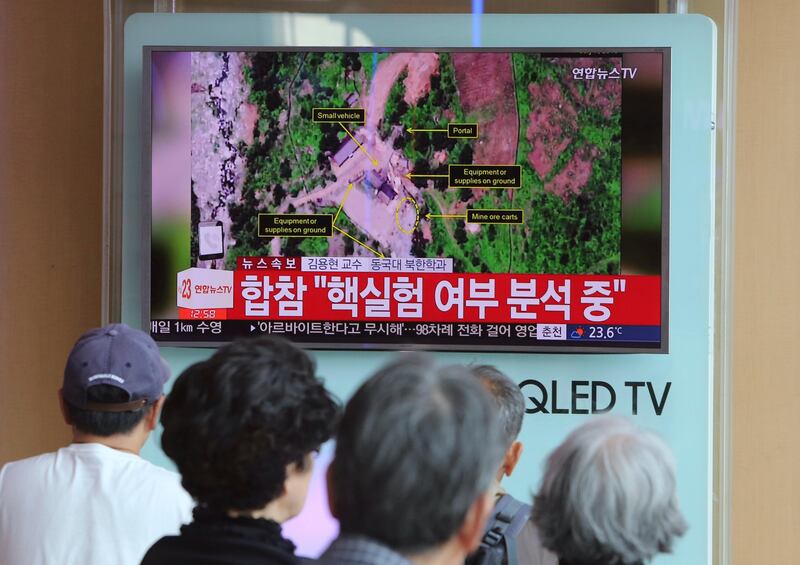Japan confirmed that North Korea had conducted a nuclear test on Sunday, lodging a formal protest with Pyongyang after a major explosion at the isolated nation's main test site sent tensions surging.
The explosion came just hours after Pyongyang claimed to have developed a hydrogen bomb that could be loaded into a long-range missile, and prime minister Shinzo Abe holding telephone talks with US president Donald Trump to discuss fears over the North's rogue weapons programme.
"The government confirms that North Korea conducted a nuclear test after examining information from the weather agency and other information," Japanese foreign minister Taro Kono told reporters.
North Korea confirms sixth nuclear test

He said Japan registered a protest with the North Korean embassy in Beijing.
Ahead of the confirmation, Mr Abe said a sixth nuclear test by Pyongyang would be "absolutely unacceptable".
Meanwhile, defence minister Itsunori Onodera said that the ministry has begun flying "sniffer" planes capable of detecting radioactive fallout.
"We'll do our best to collect information," he said, according to public broadcaster NHK.
Seismic monitors measured an “explosion” of 6.3 magnitude near North Korea’s main test site on Sunday.
The South's Joint Chiefs of Staff said in a statement that the seismic tremor was detected near the North's Punggye-ri test site.
United States Geological Survey recorded the magnitude at 6.3 — larger than any previous test.
Nuclear-armed Pyongyang has long sought the means to deliver an atomic warhead to the US, its sworn enemy.
Questions remain over whether it has successfully miniaturised its weapons, and whether it has a working H-bomb, but the official Korean Central News Agency said before the quake that leader Kim Jong-un had inspected such a device at the Nuclear Weapons Institute.
It was a "thermonuclear weapon with super explosive power made by our own efforts and technology", KCNA cited Mr Kim as saying, and "all components of the H-bomb were 100 per cent domestically made".
Pictures showed Mr Kim in black suit examining a metal casing, with a shape akin to a peanut shell.
North Korea triggered a new ramping up of tensions in July, when it carried out two successful tests of an ICBM, the Hwasong-14, which apparently brought much of the US mainland within range.
It has since threatened to send a salvo of rockets towards the US territory of Guam, and last week fired a missile over Japan and into the Pacific, the first time it has ever acknowledged doing so.
US president Donald Trump has warned Pyongyang that it faces "fire and fury", and that Washington's weapons are "locked and loaded".
Read more: North Korea says missile launch is 'prelude' to containing Guam
Mr Trump spoke by telephone to Japan's prime minister Shinzo Abe to discuss the need to "maximise pressure on North Korea" in the face of the "growing threat" it presented, according to a White House readout of the call, without specifying when it took place.
The North has repeatedly claimed that it has a thermonuclear weapon, which can be far more powerful than other nuclear devices.
When it carried out its fourth nuclear test, in January 2016, it said it was a miniaturised H-bomb, but scientists said the six-kiloton yield achieved then was far too low.
When it carried out its fifth test, in September 2016, it did not say it was a hydrogen bomb.
There was no immediate announcement from the North about Sunday's earthquake.
Yang Moo-jin of the University of North Korean Studies in Seoul, told AFP the latest KCNA report "carries a strategic message" that Pyongyang "will push for a nuclear face-off with the US as an equal".
Actually mounting a warhead onto a missile would amount to a significant escalation on the North's part, as it would create a risk that it was preparing an attack.
'Hundreds of kilotons'
The North Korean leadership says a credible nuclear deterrent is critical to the nation's survival, claiming it is under constant threat from an aggressive US.
It has been subjected to seven rounds of UN Security Council sanctions over its nuclear and ballistic missile programmes, but always insists it will continue to pursue them.
Its first nuclear test was in 2006, and successive blasts are believed to have been aimed at refining designs and reliability as well as increasing yield.
Its fifth detonation, in September last year, had a 10-kiloton yield according to Seoul — still less than the 15-kiloton US device which destroyed Hiroshima in 1945.
Atomic or "A-bombs" work on the principle of nuclear fission, where energy is released by splitting atoms of enriched uranium or plutonium encased in the warhead.
Hydrogen or H-bombs, also known as thermonuclear weapons, work on fusion and are far more powerful, with a nuclear blast taking place first to create the intense temperatures required.
In Sunday's announcement before the earthquake, KCNA said the North's H-bomb had "explosive power that can be adjusted from tens to hundreds of kilotons depending on the target", KCNA said on Sunday, claiming technological advances "on the basis of precious successes made in the first H-bomb test".
No H-bomb has ever been used in combat, but they make up most of the world's nuclear arsenals.





